Ladbergen
| Ladbergen | ||
|---|---|---|
|
Ladbergen Dorfstraße (Villagestreet) | ||
| ||
 Ladbergen | ||
Location of Ladbergen within Steinfurt district  | ||
| Coordinates: 52°08′12″N 7°44′14″E / 52.13667°N 7.73722°ECoordinates: 52°08′12″N 7°44′14″E / 52.13667°N 7.73722°E | ||
| Country | Germany | |
| State | North Rhine-Westphalia | |
| Admin. region | Münster | |
| District | Steinfurt | |
| Government | ||
| • Mayor | Udo Decker-König (Ind.) | |
| Area | ||
| • Total | 52.34 km2 (20.21 sq mi) | |
| Population (2015-12-31)[1] | ||
| • Total | 6,694 | |
| • Density | 130/km2 (330/sq mi) | |
| Time zone | CET/CEST (UTC+1/+2) | |
| Postal codes | 49549 | |
| Dialling codes | 05485 | |
| Vehicle registration | ST, TE, BF | |
| Website | www.ladbergen.de | |
Ladbergen is a municipality in the district of Steinfurt, in North Rhine-Westphalia, Germany. It is situated near the Dortmund-Ems Canal, approximately 25 km south-west of Osnabrück and 20 km north-east of Münster.
Geography
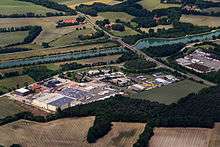
The village is situated in the Tecklenburg country in the middle between the cities Münster and Osnabrück. Because of its central location between these two cities Ladbergen is well accessible by the Autobahn (motorway/freeway) A 1 (Ladbergen junction) and the Bundesstraße (federal highway) B 475. The Dortmund-Ems Canal (canal port Ladbergen) situated on the western municipal border and Münster Osnabrück International Airport (FMO) are located a few kilometers from the centre of Ladbergen. Unlike the name part of "bergen" suggests, Ladbergen offers no mountainous or hilly landscape, but is situated at a relatively uniform level between 48.1 m (158 ft) and 55.5 m (182 ft) with a mean elevation of 51.8 m (170 ft) above sea level. Two streams flow through Ladbergen, the Ladbergen Aa and the Ladbergen Mühlenbach that both flow eventually into the Glane stream.
The municipality Ladbergen is subdivided in the village(centre) and the surrounding rural areas Hölter, Wester and Overbeck.
Neighboring municipalities and towns
Ladbergen borders on:
Population
With a population of 6,370 (census of 30 June 2011) Ladbergen is the second smallest independent municipality in the district of Steinfurt (just before Laer with 6,298 inhabitants). 3,221 women and 3,149 men were living in the municipality. The camping facilities offer about 700 more people a second home in Ladbergen.
Regarding religion the largest part of the population is Protestant (Lutheranism), a smaller part is Roman Catholic.
History

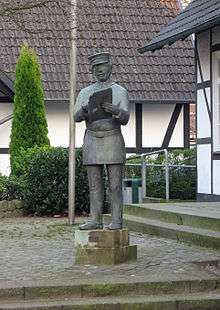
Because of graves found, it is assumed that the territory of the municipality Ladbergen was already populated in the Bronze Age. Ladbergen got mentioned first in 950 in a certificate of the Freckenhorst monastery.
In the year 1149, the municipality was assigned as an independent parish by the Diocese of Münster. In 1170 the parish was taken over by the Diocese of Osnabrück.
In 1246 the Ladberger Marktbund (Ladbergen Marketfederation) was founded by representatives of the cities Münster, Osnabrück, Minden and Herford. This was a precursor of other forms of cooperation in Westphalia and the Hanseatic League.
Around 1400, the western parts of the community were lost to the Diocese of Münster. As a result, the population of Ladbergen until after World War II remained religiously almost exclusively Protestant (Lutheranism).
In the year 1650 Ladbergen gained political autonomy for the first time. In 1707 Ladbergen with the entire Duchy of Tecklenburg got incorporated into the Kingdom of Prussia. After 1816 Ladbergen belonged to the Landkreis Münster and was later assigned to the Landkreis Tecklenburg.
In 1855 Ladbergen lost its political autonomy, and was administratively unified with the village Brochterbeck. This situation remained unchanged up to 1907, when Ladbergen was assigned to Tecklenburg.
During World War II the vicinity of Ladbergen was heavily bombed.[3] Allied bombers tried to destroy the Dortmund-Ems Canal aqueducts near Ladbergen, where the canal passes over the Mühlenbach to render the canal useless for extended periods.[[4] To defend the canal there were two heavy 105 mm Flak locations in Ladbergen, supported by smaller anti-aircraft guns. Batteries of 105 mm guns were usually left to defend major cities. This indicates the importance of the canal to the overall German war effort. Besides bombs and downed airplanes shrapnel fell onto Ladbergen during the air raids causing loses in property and lives. The air raids did not result in the destruction of the targeted aqueducts, but Tallboy bombs dropped by Avro Lancaster bombers of No. 617 Squadron RAF did breach the canal banks on 23/24 September 1944.[5]
In September 1949 Ladbergen regained its political autonomy. In January 1975 Ladbergen was transferred from the then dissolved district of Tecklenburg into the newly founded district of Steinfurt.
Noticeable facts
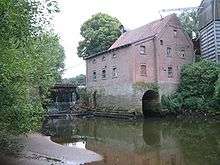
- About 37% of the population of the village emigrated during the 19th century. This was the highest emigration rate in Germany during that era.
- Peasants from Ladbergen often gained extra income by working in the Netherlands for extended periods.
- Many families from Ladbergen have family names, which in the recent past only existed in Ladbergen – such as Gehde, Rahmeier, Schoppenhorst, Wibbeler, Wiethaupt and Wiethölter.
- The predominant spoken language in Ladbergen was up to the 1930s almost exclusively Ladbergen Platt, a variant of the established Low German dialects. A 2009 survey concluded that just over 700 of the original inhabitants (11% of the population) still can speak this local dialect, though actively speaking the dialect is mostly reserved to the over-70-year-olds.[6][7]
- Since the founding of the Federal Republic of Germany in the year 1949, Ladbergen is one of the "strongholds" of the Free Democratic Party in the Münsterland and throughout Germany.
Economy
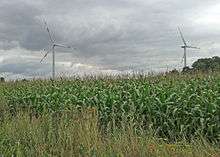
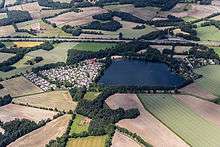
For centuries the economy of Ladbergen was based on agriculture. The introduction of fertilizer in the 20th century enabled the local peasants – who up to that moment had to deal with infertile sandy soil that yielded modest harvests – to escape from poverty. The infrastructural improvements and urbanization of the village after World War II and the West German Wirtschaftswunder created new jobs in trade, industry, transport, tourism and the service sector and commuters settled in Ladbergen. These developments diversified and boosted the economic development of Ladbergen. The last decades the municipality itself also profited from the establishment of new successful businesses and companies in Ladbergen and general prosperity amongst its citizens, by a steady increase in local taxes revenues. This enabled the municipality to invest in the local infrastructure, education and (social) services for its citizens.
Energy supply
In 2005 a wind farm consisting of three REpower MM82 wind turbines was erected on the outskirts of Ladbergen.[8] Each of these MM82 wind turbines has a 80.0 m (262.5 ft) hub height and 82.0 m (269.0 ft) rotor diameter giving a total sweep of 5,281 m2 (56,844 sq ft) and an average power capacity of 2.050 kW. The power output is controlled by varying the pitch of the rotor blades which can operate at 8.5–17.1 rpm rotor speed.[9] Together with the two anaerobic digestion plants that went into operation in 2006, the community - mathematically - can fulfill its energy needs. Another quite large biogas powerplant is being built on the site of the oil mill at the canal harbor Ladbergen. This plant will produce a multiple of the Ladbergen energy needs.
Local government
Town council
The most recent town council election of Ladbergen was conducted on 30 August 2009. The town council currently consists of 22 seats divided between several political parties.[10][11] These political parties are also represented in the Bundestag (the German national parliament) in Berlin.
Election results
German town council members are elected for a 5-year term and regular elections are held every five years.
| Town council of Ladbergen elections | 1994 | 1999 | 2004 | 2009 | 2014 |
|---|---|---|---|---|---|
| Political party | Seats / % | Seats / % | Seats / % | Seats / % | Seats / % |
| Christian Democratic Union of Germany (CDU) | 9 / 41.0% | 8 / 37.6% | 8 / 35.9% | 7 / 33.1% | 8 / 37.6% |
| Social Democratic Party of Germany (SPD) | 8 / 37.5% | 8 / 35.6% | 6 / 28.5% | 7 / 29.6% | 7 / 33.3% |
| Free Democratic Party (FDP) | 1 / 8.3% | 4 / 16.3% | 5 / 22.4% | 5 / 17,7% | 3 / 13.1% |
| Alliance 90/The Greens (Bündnis 90/Die Grünen) | 3 / 13.2% | 2 / 10.5% | 3 / 13.2% | 3 / 13.6% | 4 / 16.0% |
| Total | 21 / 100% | 22 / 100% | 22 / 100% | 22 / 100% | 22 / 100% |
The next scheduled town council election is in 2020.
Mayor
The Bürgermeister (mayor) of Ladbergen is since 1999 elected directly by the EU citizens living in the municipality. The mayor is elected for a 5-year term and regular elections are held every five years. The post may be said to be a professional one, the mayor being the head of the local government, and requiring, in order to be eligible, a training in administration.
The most recent election for mayor was conducted on 28 May 2014. Out of two candidates the independent candidate Mr. Udo Decker-König was reelected as mayor of Ladbergen.[12]
As first Stellvertretende Bürgermeister (deputy mayor) the town council elected Mr. Hartmut Kotlewski (CDU). As second Stellvertretende Bürgermeister the town council elected Mr. Reinhard Kemper (SPD).[13]
Mayors of Ladbergen
- Wolfgang Menebröcker (independent) 1999–2009
- Udo Decker-König (independent) 2009 –
The next scheduled mayor election is in 2020.
Coat of arms

Blazon: Under a red shield top with two golden bees, in silver field three (2 : 1) red nymphaea leaves.
The bees refer to beekeeping. On the heath and moorland of Ladbergen beekeeping was widespread for centuries. According to a historic certificate honey farmers from Ladbergen had to pay taxes to the monastery Freckenhorst in the year 950.
The three Nymphaea or water lilies come from the seal of the Lord of Ladbergen from the year 1324. The water lilies symbol originates from the Duchy Lingen, to which Ladbergen belonged during a medieval period. The leaf shape has its origin in the coat of arms of the Counts of Tecklenburg.
Sister village
 New Knoxville, Ohio, United States
New Knoxville, Ohio, United States
A lot of emigrants originating from Ladbergen settled down in the area around New Knoxville in the state of Ohio in the United States with which Ladbergen established a town partnership. New Knoxville is partly composed of the descendants of the Ladbergen emigrants. The typical Ladbergen Platt dialect is still spoken by some of the older citizens whose ancestors originated from Ladbergen.[14]
Due to the interest of American descendants of emigrants from Ladbergen in their family genealogy, more or less reliable private genealogical work was conducted after World War II. As Neil Armstrong, whose great-grandfather Friedrich Wilhelm Kötter emigrated from Ladbergen to the United States in 1864, was the first man to walk on the moon in 1969, many citizens of Ladbergen became interested in their American "relatives". This resulted in a very close connection between Ladbergen and New Knoxville, which is especially cultivated by reciprocal visits.[14][15] For the New Knoxville sesquicentennial in 1986, approximately 100 Ladbergen residents traveled to New Knoxville to join in the celebration.
References
- ↑ "Amtliche Bevölkerungszahlen". Landesbetrieb Information und Technik NRW (in German). 18 July 2016.
- ↑ Afrouper sculpture Gemeinde Ladbergen (German)
- ↑ The Effect on the Local Communities "When the canal is full then it is time to be careful"...old Ladbergen saying.
- ↑ The Dortmund-Ems Canal at Ladbergen
- ↑ "Campaign Diary". Royal Air Force Bomber Command 60th Anniversary. UK Crown. Retrieved 24 May 2007. 1944: September
- ↑ „Plattdeutsch auf der roten Liste“ Westfälische Nachrichten 9 April 2009 by Erhard Kurlemann (German)
- ↑ "Äs alle Katten noa gries wörn" Westfälische Nachrichten 8 April 2009 by Erhard Kurlemann (German)
- ↑ REpower References
- ↑ REpower MM82 brochure
- ↑ Election results of Ladbergen (German)
- ↑ 2009 Town council election results of Ladbergen (German)
- ↑ Mayor election Ladbergen
- ↑ Konstituierende Sitzung mit Wahl der stellvertretenden Bürgermeister Rat nimmt seine Arbeit auf Westfälische Nachrichten 4 July 2014 by Michael Baar (German)
- 1 2 Official website of the municipality of Ladbergen – The history of Ladbergen
- ↑ "Der schwere Anfang in Ohio" Westfälische Nachrichten 6 November 2009 (German)
External links
| Wikimedia Commons has media related to: |
- Official website of the municipality of Ladbergen (German)
- Official website of the municipality of Ladbergen – The history of Ladbergen
- Kommunalprofil (community profile) Ladbergen Information und Technik Nordrhein-Westfalen (IT.NRW) Geschäftsbereich Statistik (German)
- Website of the sister village New Knoxville (Ohio), USA
- New Knoxville Historical Society "From Ladbergen to America" by Dean Hoge
